Accurate Mapping and Evaluation of Small Impact Craters within the Lunar Landing Area
Abstract
:1. Introduction
- (1)
- For the comprehensive identification of small lunar craters, we designed a feature amplification strategy using the original grayscale image to enhance the target pixels of small craters and decrease the impact of dense distribution. After this point, small lunar impact craters can be accurately identified through the use of deep convolutional networks [5].
- (2)
- To verify the effectiveness of the identification model, ten returned samples’ lunar probe landing areas [22], including the Apollo series detectors of the United States, the Soviet Union’s Luna program, and China’s Chang’e-5 detector [23], were selected as the research area for small lunar crater recognition. These areas have significant geological significance and lack sufficient identification of small impact craters.
- (3)
- An intelligent recognition-based small lunar crater dataset was developed, including 413,777 craters with diameters greater than 4.5 m (the greatest quantity among the existing automatically detected small crater catalogs). According to a density distribution and random analysis, the spatial distribution characteristics of the small lunar impact craters over different geological times in the landing areas were derived. The derived data offer important evidence regarding the Moon’s geological evolution.
2. Data and Methods
2.1. Description of the Dataset
2.2. Small Crater Identification Model Based on the Feature Amplification Strategy
2.2.1. Feature Amplification Strategy
2.2.2. Small Lunar Crater Identification Model
3. Experiments and Results
3.1. Experiment Design
3.1.1. Training Strategy
3.1.2. Evaluation Metrics
3.1.3. Implementation Details and Parameter Settings
3.2. Results
3.2.1. Identified Results in the Test Area
3.2.2. Small Lunar Crater Dataset within the Lunar Landing Areas
4. Discussion
4.1. The Completeness of Small Lunar Impact Craters
4.2. Density Distribution and Random Analysis of Small Lunar Impact Craters
4.3. Further Discussion on the Conducted Experiments
5. Conclusions
Supplementary Materials
Author Contributions
Funding
Data Availability Statement
Conflicts of Interest
References
- Head, J.W.; Fassett, C.I.; Kadish, S.J.; Smith, D.E.; Zuber, M.T.; Neumann, G.A.; Mazarico, E. Global Distribution of Large Lunar Craters: Implications for Resurfacing and Impactor Populations. Science 2010, 329, 1504–1507. [Google Scholar] [CrossRef] [PubMed]
- Salamunićcar, G.; Lončarić, S.; Grumpe, A.; Wöhler, C. Hybrid Method for Crater Detection Based on Topography Reconstruction from Optical Images and the New LU78287GT Catalogue of Lunar Impact Craters. Adv. Space Res. 2014, 53, 1783–1797. [Google Scholar] [CrossRef]
- Wang, J.; Cheng, W.; Zhou, C. A Chang’E-1 Global Catalog of Lunar Impact Craters. Planet. Space Sci. 2015, 112, 42–45. [Google Scholar] [CrossRef]
- Robbins, S.J. A New Global Database of Lunar Impact Craters >1–2 km: 1. Crater Locations and Sizes, Comparisons with Published Databases, and Global Analysis. J. Geophys. Res. Planets 2009, 124, 871–892. [Google Scholar] [CrossRef]
- Yang, C.; Zhao, H.S.; Bruzzone, L.; Benediktsson, J.A.; Liang, Y.; Liu, B.; Zeng, X.G.; Guan, R.C.; Li, C.L.; Ouyang, Z.Y. Lunar Impact Crater Identification and Age Estimation with Chang’E Data by Deep and Transfer Learning. Nat. Commun. 2020, 11, 6358. [Google Scholar] [CrossRef] [PubMed]
- Robinson, M.S.; Boyd, A.K.; Denevi, B.W.; Lawrence, S.J.; McEwen, A.S.; Moser, D.E.; Povilaitis, R.Z.; Stelling, R.W.; Suggs, R.M.; Thompson, S.D.; et al. New Crater on the Moon and A Swarm of Secondaries. Icarus 2015, 252, 229–235. [Google Scholar] [CrossRef]
- Fassett, C.I.; Thomson, B.J. Crater degradation on the lunar Maria: Topographic Diffusion and the Rate of Erosion on the Moon: Crater Degradation on the Lunar Maria. J. Geophys. Res. Planets 2014, 119, 2255–2271. [Google Scholar] [CrossRef]
- Yang, X.; Fa, W.Z.; Du, J.; Xie, M.G.; Liu, T.T. Effect of Topographic Degradation on Small Lunar Craters: Implications for Regolith Thickness Estimation. Geophys. Res. Lett. 2021, 48, e2021GL095537. [Google Scholar] [CrossRef]
- Alfred, S.M.; Edward, B.B. The Importance of Secondary Cratering to Age Constraints on Planetary Surfaces. Annu. Rev. Earth Planet. Sci. 2006, 34, 535–567. [Google Scholar]
- Li, Y.; Basilevsky, A.T.; Xie, M.G.; Ip, W.-H. Correlations Between Ejecta Boulder Spatial Density of Small Lunar Craters and the Crater Age. Planet. Space Sci. 2018, 162, 52–61. [Google Scholar] [CrossRef]
- Mahanti, P.; Robinson, M.S.; Thompson, T.J.; Henriksen, M.J. Small Lunar Craters at the Apollo 16 and 17 Landing Sites—Morphology and Degradation. Icarus 2018, 299, 475–501. [Google Scholar] [CrossRef]
- Shi, K.; Yue, Z.Y.; Di, K.C.; Liu, J.Z.; Dong, Z.H. The Gardening Process of Lunar Regolith by Small Impact Craters: A Case Study in Chang’E-4 Landing Area. Icarus 2022, 377, 114908. [Google Scholar] [CrossRef]
- Jia, B.J.; Fa, W.Z.; Xie, M.G.; Tai, Y.S.; Liu, X.F. Regolith Properties in the Chang’E-5 Landing Region of the Moon: Results from Multi-Source Remote Sensing Observations. J. Geophys. Res. Planets 2021, 126, e2021JE006934. [Google Scholar] [CrossRef]
- Zuo, W.; Li, C.L.; Yu, L.J.; Zhang, Z.B.; Wang, R.W.; Zeng, X.G.; Liu, Y.X.; Xiong, Y.Y. Shadow–Highlight Feature Matching Automatic Small Crater Recognition Using High-Resolution Digital Orthophoto Map from Chang’E Missions. Acta Geophys. 2019, 38, 541–554. [Google Scholar] [CrossRef]
- Kang, Z.; Wang, X.; Hu, T.; Yang, J.T. Coarse-to-Fine Extraction of Small-Scale Lunar Impact Craters from the CCD Images of the Chang’E Lunar Orbiters. IEEE Trans. Geosci. Electron. 2019, 57, 181–193. [Google Scholar] [CrossRef]
- Cadogan, P.H. Automated Precision Counting of Very Small Craters at Lunar Landing Sites. Icarus 2020, 348, 113822. [Google Scholar] [CrossRef]
- Hu, Y.F.; Xiao, J.; Liu, L.P.; Zhang, L.; Wang, Y. Detection of Small Impact Craters via Semantic Segmenting Lunar Point Clouds Using Deep Learning Network. Remote Sens. 2021, 13, 1826. [Google Scholar] [CrossRef]
- Yang, H.; Xu, X.C.; Ma, Y.Q.; Xu, Y.M.; Liu, S.C. CraterDANet: A Convolutional Neural Network for Small-Scale Crater Detection via Synthetic-to-Real Domain Adaptation. IEEE Trans. Geosci. Remote Sens. 2022, 60, 1–12. [Google Scholar] [CrossRef]
- Fairweather, J.H.; Lagain, A.; Servis, K.; Benedix, G.K.; Kumar, S.S.; Bland, P.A. Automatic Mapping of Small Lunar Impact Craters Using LRO-NAC Images. Earth Space Sci. 2022, 9, 1–19. [Google Scholar] [CrossRef]
- Cadogan, P.H. Automated Precision Counting of Small Lunar Craters—A Broader View. Icarus 2024, 408, 115796. [Google Scholar] [CrossRef]
- Saxena, L. Computer Vision Metrics: Survey, Taxonomy, and Analysis. Comput. Rev. 2015, 56, 350. [Google Scholar]
- Wilhelms, D.E.; McCauley, J.F.; Trask, N.J. The Geologic History of the Moon; U.S. Geological Survey Professional Paper 1348; U.S. Geological Survey: Denver, CO, USA, 1987. [Google Scholar]
- Li, Q.L.; Zhou, Q.Y.; Liu, Y.; Xiao, Z.Y.; Lin, Y.T.; Li, J.H.; Ma, H.X.; Tang, G.Q.; Guo, S.; Tang, X.; et al. Two-billion-year-old Volcanism on the Moon from Chang’e-5 Basalts. Nature 2021, 600, 54–58. [Google Scholar] [CrossRef]
- He, K.; Zhang, X.; Ren, S.; Sun, J. Deep Residual Learning for Image Recognition. In Proceedings of the IEEE Conference on Computer Vision and Pattern Recognition (CVPR), Las Vegas, NV, USA, 27–30 June 2016; pp. 770–778. [Google Scholar]
- Dai, J.F.; Li, Y.; He, K.M. R-FCN: Object Detection via Region-based Fully Convolutional Networks. In Proceedings of the 30th Conference on Neural Information Processing Systems (NIPS), Barcelona, Spain, 5–10 December 2016; pp. 379–387. [Google Scholar]
- Russakovsky, O.; Deng, J.; Su, H.; Krause, J.; Satheesh, S.; Ma, S.; Huang, Z.H.; Karpathy, A.; Khosla, A.; Bernstein, M.; et al. ImageNet Large Scale Visual Recognition Challenge. Int. J. Comput. Vision 2015, 115, 211–252. [Google Scholar] [CrossRef]
- Robbins, S.J.; Hynek, B.M. A New Global Database of Mars Impact Craters ≥1 km: 1. Database Creation, Properties, and Parameters. J. Geophys. Res. 2012, 117, 18. [Google Scholar] [CrossRef]
- Strom, R.G.; Malhotra, R.; Xiao, Z.Y.; Ito, T.; Yoshida, F.; Ostrach, L.R. The Inner Solar System Cratering Record and the Evolution of Impactor Populations. Res. Astron. 2015, 15, 407–434. [Google Scholar] [CrossRef]
- Kneissl, T.; Van, G.S.; Neukum, G. Map-Projection-Independent Crater Size-Frequency Determination in GIS Environments—New Software Tool for ArcGIS. Planet. Space Sci. 2011, 59, 1243–1254. [Google Scholar] [CrossRef]
- Michael, G.G.; Platz, T.; Kneissl, T.; Schmedemann, N. Planetary Surface Dating from Crater Size–Frequency Distribution Measurements: Spatial Randomness and Clustering. Icarus 2012, 218, 169–177. [Google Scholar] [CrossRef]
- Zeng, X.G.; Liu, D.W.; Chen, Y.; Zhou, Q.; Ren, X.; Zhang, Z.B.; Yan, W.; Chen, W.; Wang, Q.; Deng, X.; et al. Landing Site of the Chang’e-6 Lunar Farside Sample Return Mission from the Apollo Basin. J. Nat. Astron. 2023, 7, 1188–1197. [Google Scholar] [CrossRef]
- Richardson, M.; Malagón, A.A.P.; Lebofsky, L.A.; Grier, J.; Gay, P.; Robbins, S.J.; Team, T.C. The CosmoQuest Moon Mappers Community Science Project: The Effect of Incidence Angle on the Lunar Surface Crater Distribution. Open J. Astrophys. 2022, 5, 13404. [Google Scholar] [CrossRef]



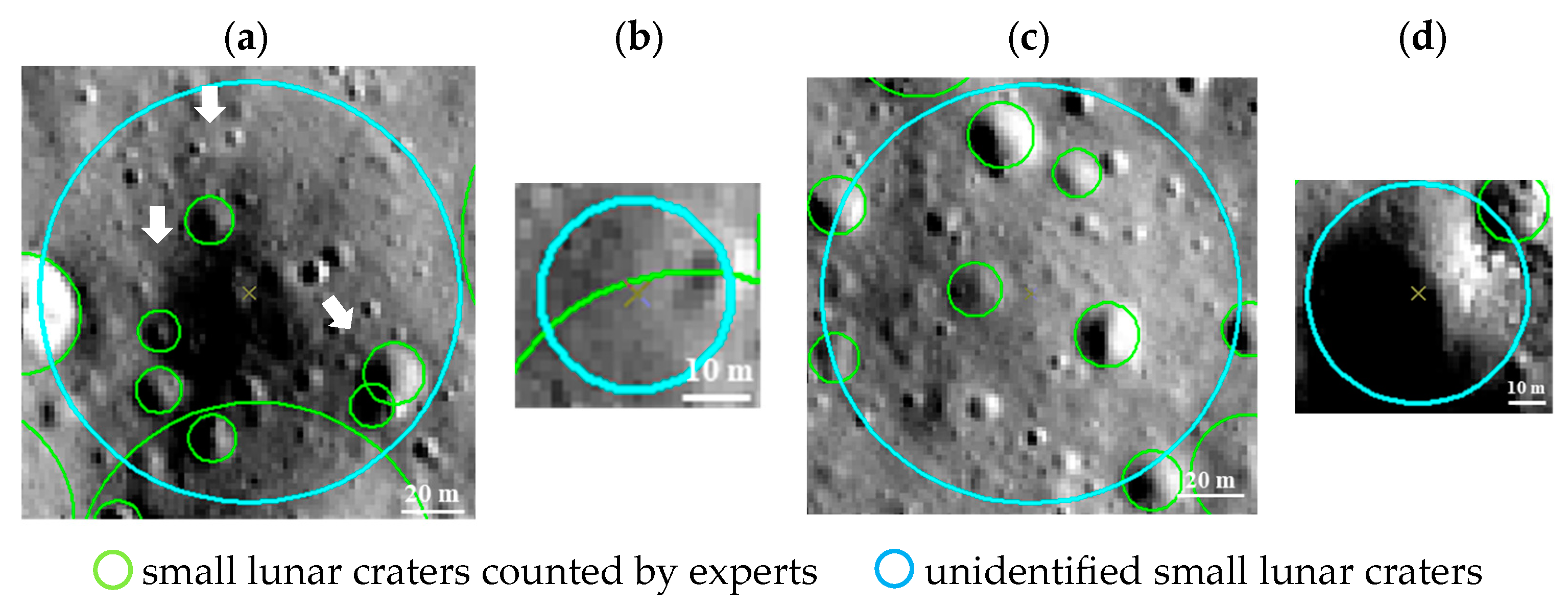
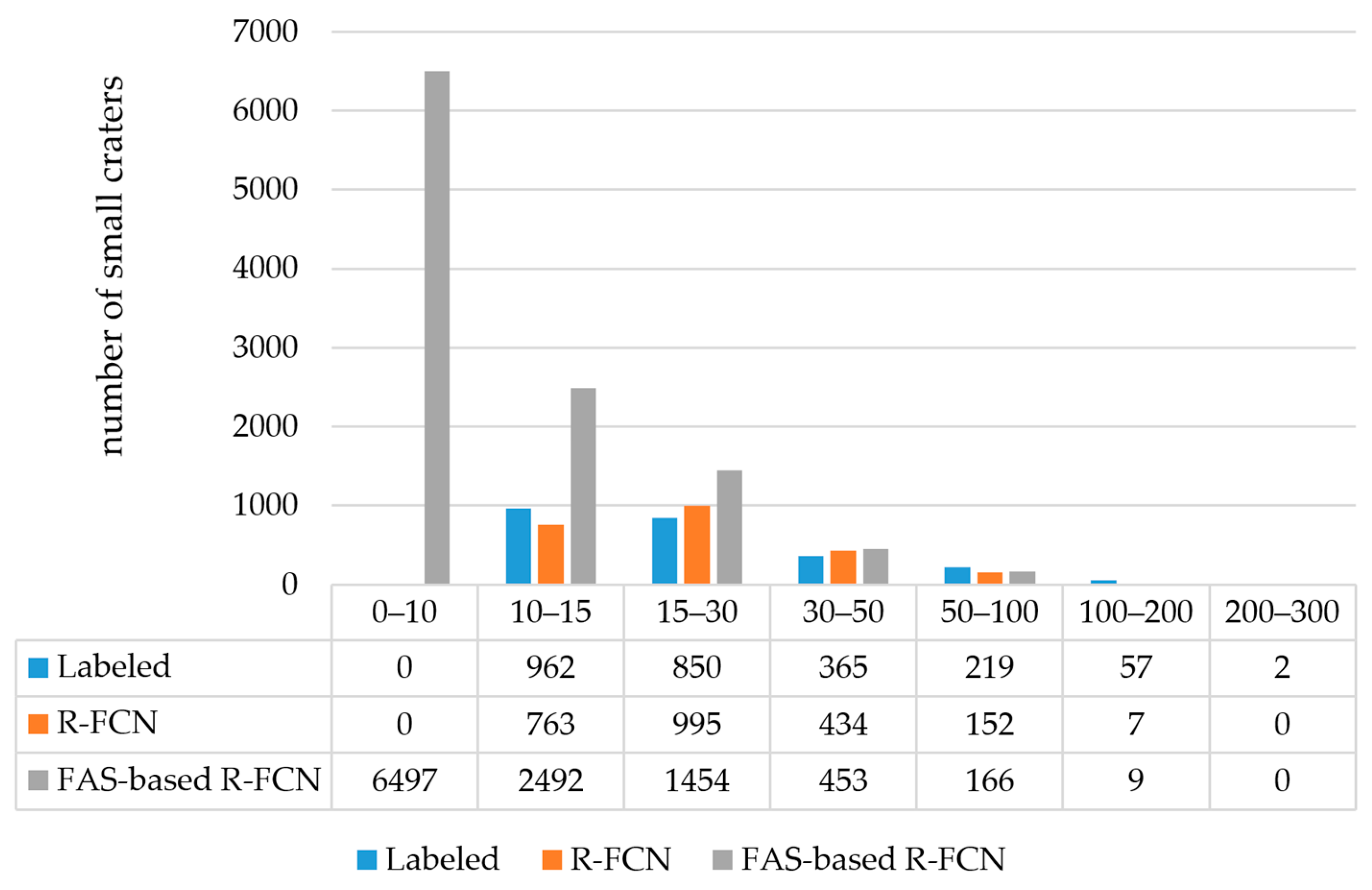
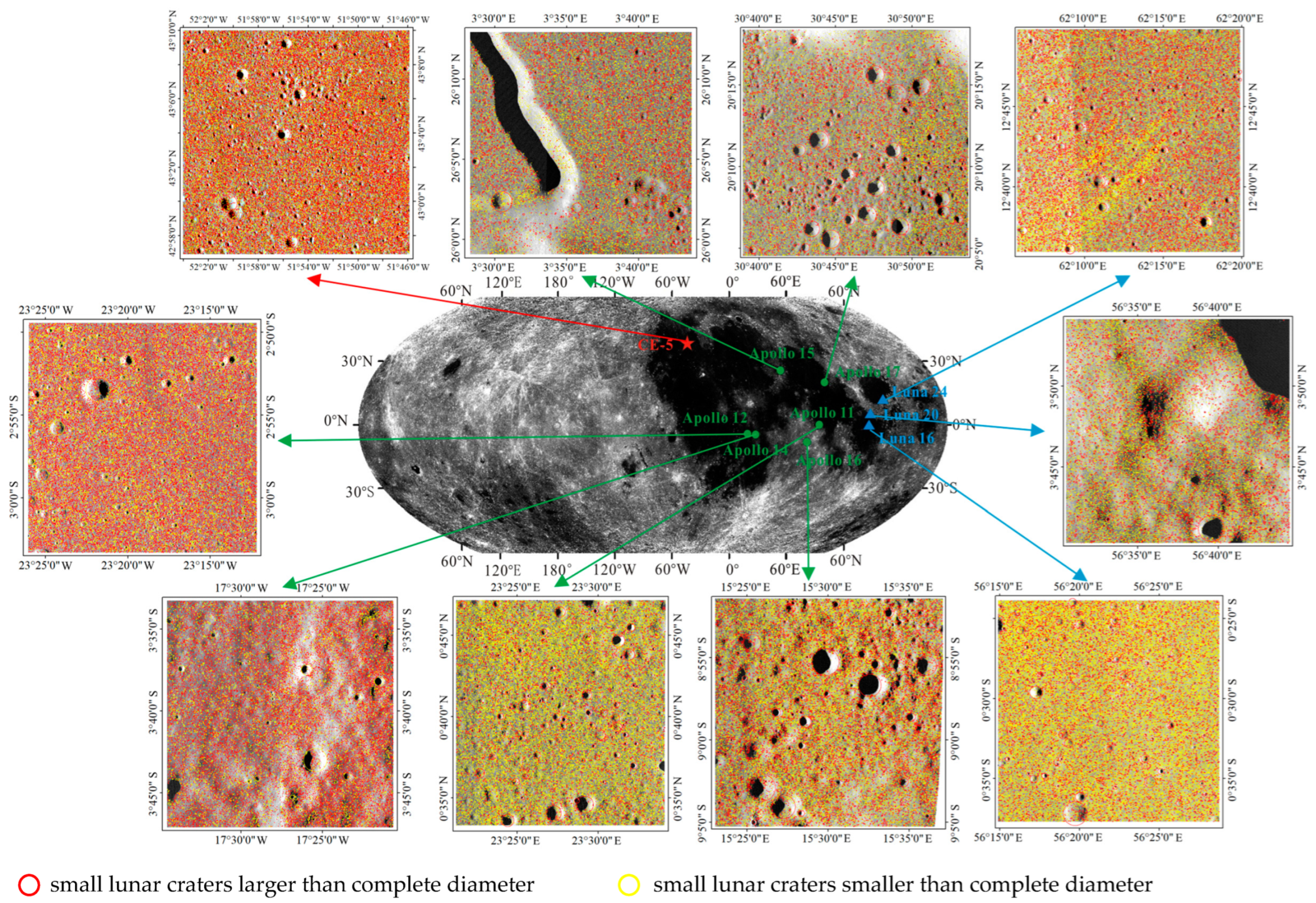
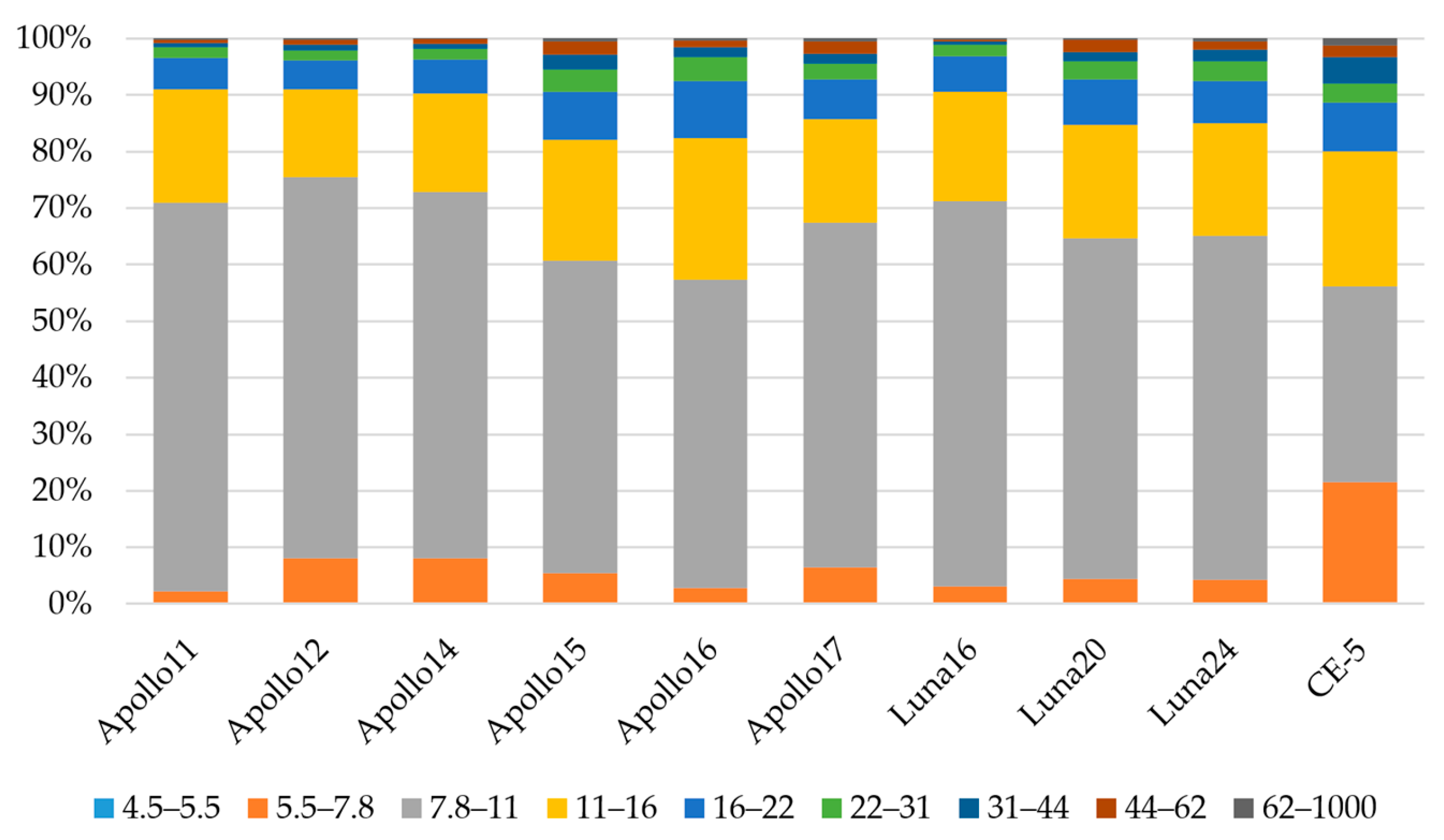

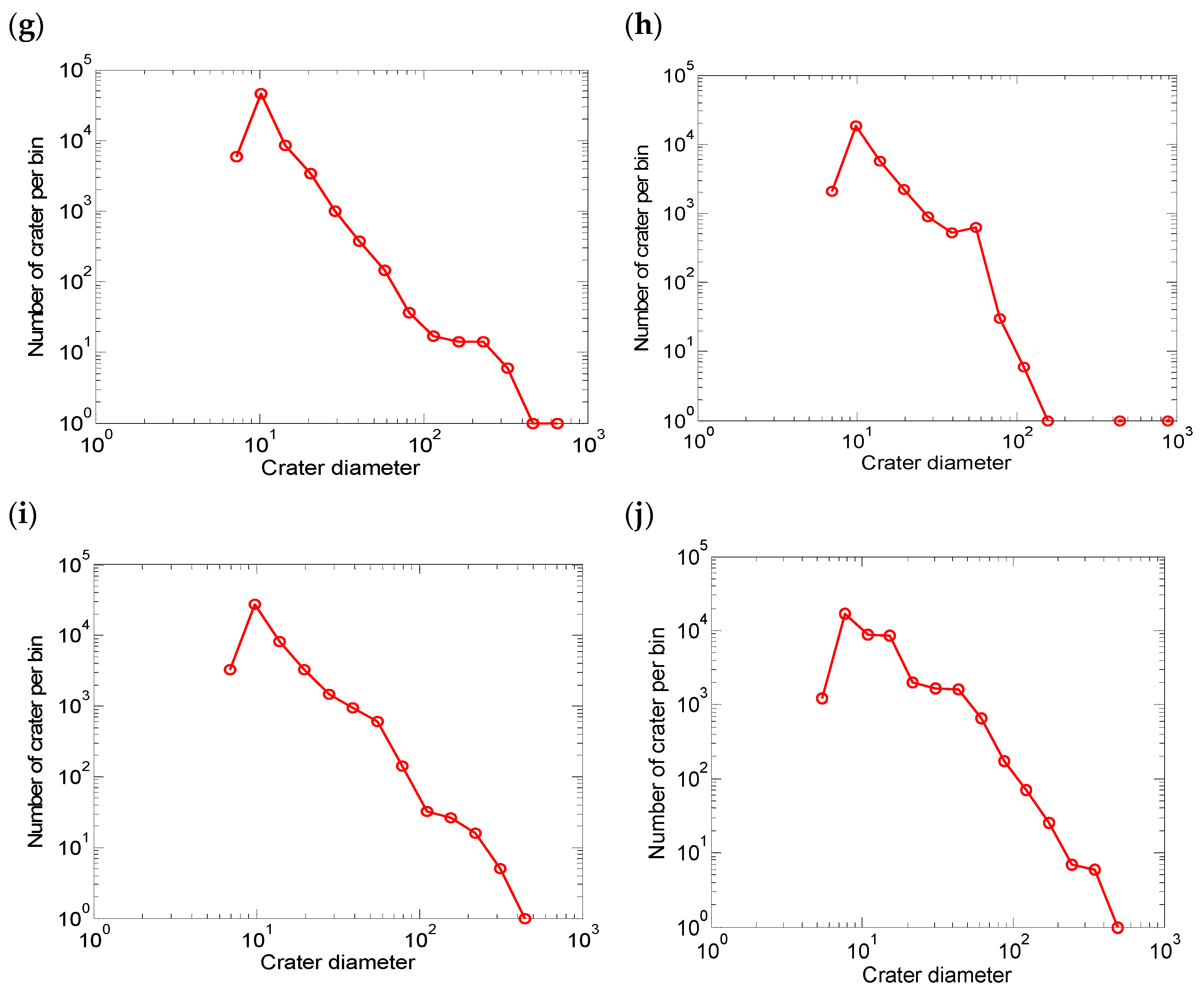
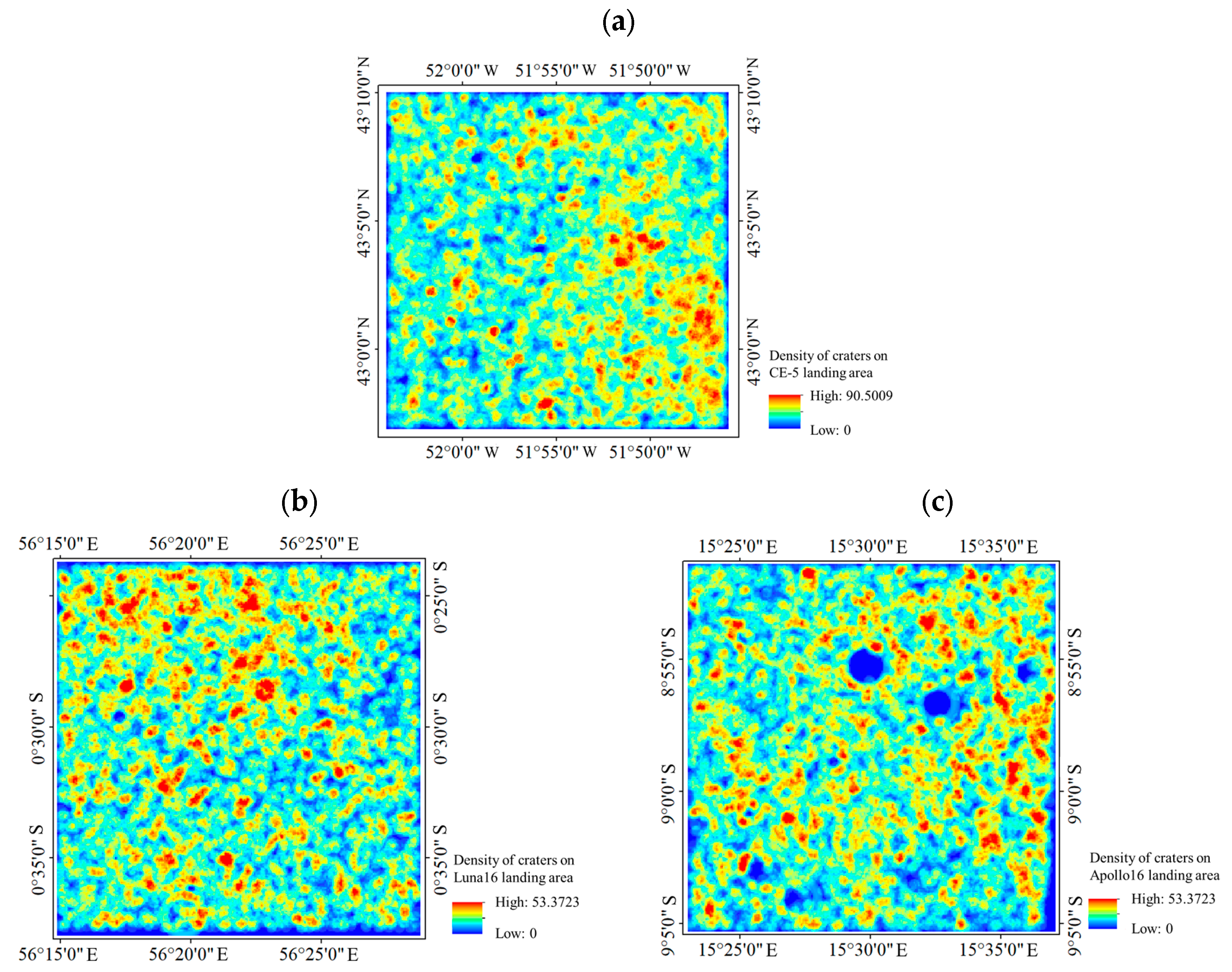

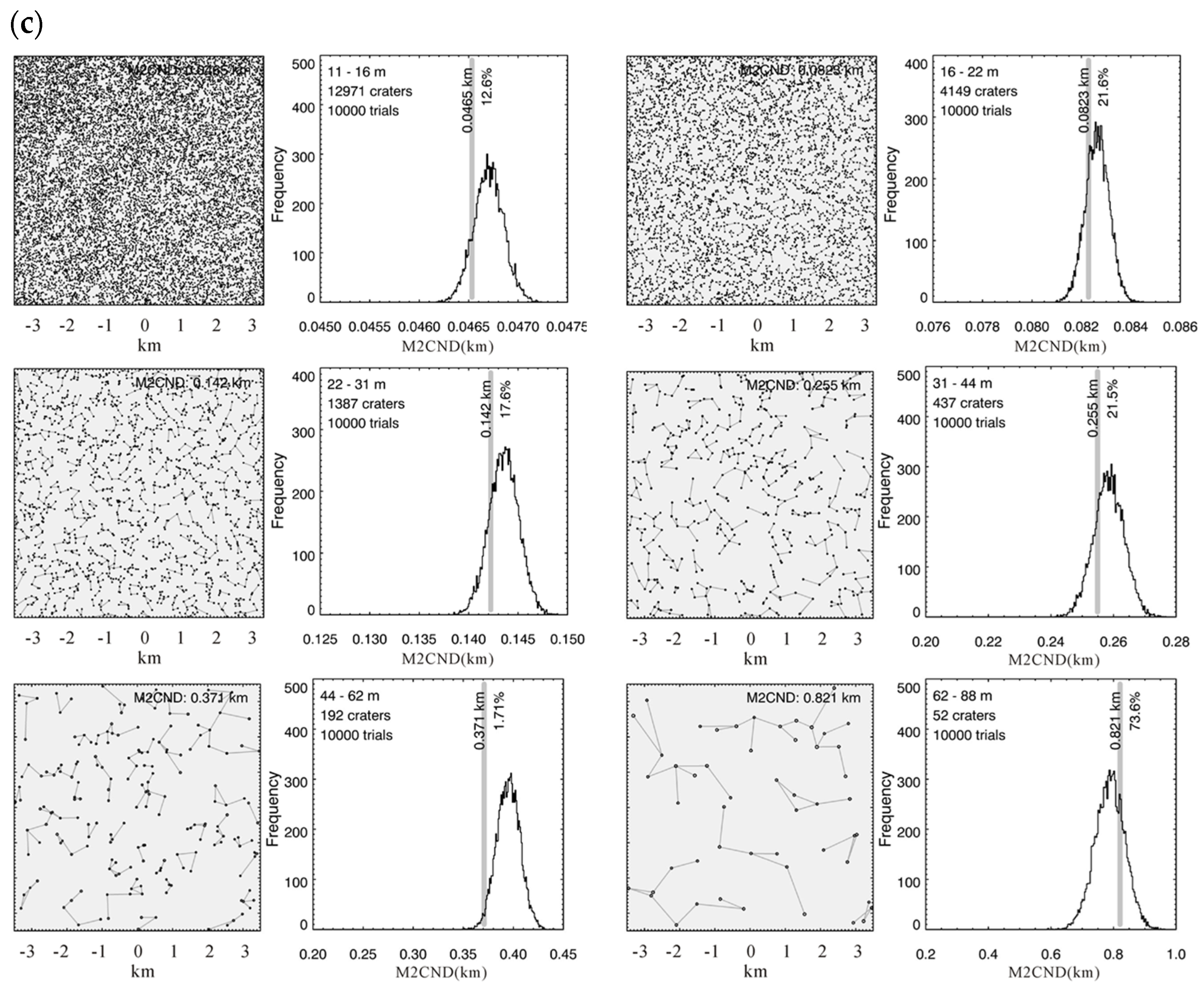
| Landing Area/ Training and Test Regions | Longitude | Latitude |
|---|---|---|
| Apollo 11 | 23°34′10′–23°21′50″E | 00°33′40″–00°47′10″N |
| Apollo 12 | 23°12′10″–23°26′10″W | 02°50′50″–03°03′30″S |
| Apollo 14 | 17°20′40″–17°34′40″W | 03°33′20″–03°47′10″S |
| Apollo 15 | 03°30′10″–03°43′50″E | 25°59′10″–26°13′00″N |
| Apollo 16 | 15°23′00″–15°37′05″W | 08°51′25″–09°05′10″S |
| Apollo 17 | 23°21′10″–23°34′10″E | 00°33′20″–00°47′10″N |
| Luna 16 | 56°14′50″–56°28′40″E | 00°23′50″–00°37′40″S |
| Luna 20 | 56°30′40″–56°44′20″E | 03°40′20″–03°54′10″N |
| Luna 24 | 62°05′40″–62°19′50″E | 12°36′00″–12°49′50″N |
| Chang’e-5 | 52°04′00″–51°45′50″W | 42°56′55″–43°10′00″N |
| Training | 52°40′30″–52°29′20″W | 45°10′40″–45°17′30″N |
| Test | 50°34′00″–53°02′00″W | 43°08′10″–43°34′00″N |
| Region | Labeled Samples | R-FCN | FAS-Based R-FCN | ||||
|---|---|---|---|---|---|---|---|
| Identified Craters | Recall | FPRs | Identified Craters | Recall | FPRs | ||
| A | 573 | 572 | 32.41% | 0.72% | 2670 | 86.91% | 0.52% |
| B | 508 | 493 | 34.64% | 0.83% | 2914 | 88.78% | 0.79% |
| C | 872 | 799 | 33.16% | 0.54% | 2978 | 86.12% | 0.34% |
| D | 502 | 487 | 32.32% | 0.69% | 2509 | 86.06% | 0.52% |
| Total | 2455 | 2351 | 33.09% | 0.70% | 11,071 | 86.84% | 0.54% |
| Average | 33.13% | 0.70% ± 0.10% | 86.97% | 0.54% ± 0.16% | |||
| Landing Area | Minimum Diameter (m) | Maximum Diameter (m) | Complete Diameter (m) | Number of Craters (Automatic Mapping) | Number of Craters (>Complete Diameter) |
|---|---|---|---|---|---|
| Apollo 11 | 6.21 | 525.4 | 15 | 45,102 | 4511 |
| Apollo 12 | 5.48 | 760 | 13 | 52,481 | 7458 |
| Apollo 14 | 5.5 | 724.03 | 13 | 38,992 | 5995 |
| Apollo 15 | 5.98 | 651 | 14 | 22,519 | 5017 |
| Apollo 16 | 6 | 840.6 | 14 | 42,660 | 9380 |
| Apollo 17 | 5.75 | 616.6 | 14 | 27,143 | 4781 |
| Luna 16 | 6 | 754.32 | 14 | 66,924 | 8527 |
| Luna 20 | 5.5 | 812.83 | 14 | 30,187 | 5733 |
| Luna 24 | 5.75 | 373.86 | 14 | 45,761 | 8409 |
| Chang’e-5 | 4.5 | 516 | 11 | 42,008 | 18,418 |
Disclaimer/Publisher’s Note: The statements, opinions and data contained in all publications are solely those of the individual author(s) and contributor(s) and not of MDPI and/or the editor(s). MDPI and/or the editor(s) disclaim responsibility for any injury to people or property resulting from any ideas, methods, instructions or products referred to in the content. |
© 2024 by the authors. Licensee MDPI, Basel, Switzerland. This article is an open access article distributed under the terms and conditions of the Creative Commons Attribution (CC BY) license (https://creativecommons.org/licenses/by/4.0/).
Share and Cite
Yang, C.; Wang, X.; Zhao, D.; Guan, R.; Zhao, H. Accurate Mapping and Evaluation of Small Impact Craters within the Lunar Landing Area. Remote Sens. 2024, 16, 2165. https://doi.org/10.3390/rs16122165
Yang C, Wang X, Zhao D, Guan R, Zhao H. Accurate Mapping and Evaluation of Small Impact Craters within the Lunar Landing Area. Remote Sensing. 2024; 16(12):2165. https://doi.org/10.3390/rs16122165
Chicago/Turabian StyleYang, Chen, Xinglong Wang, Dandong Zhao, Renchu Guan, and Haishi Zhao. 2024. "Accurate Mapping and Evaluation of Small Impact Craters within the Lunar Landing Area" Remote Sensing 16, no. 12: 2165. https://doi.org/10.3390/rs16122165
APA StyleYang, C., Wang, X., Zhao, D., Guan, R., & Zhao, H. (2024). Accurate Mapping and Evaluation of Small Impact Craters within the Lunar Landing Area. Remote Sensing, 16(12), 2165. https://doi.org/10.3390/rs16122165





